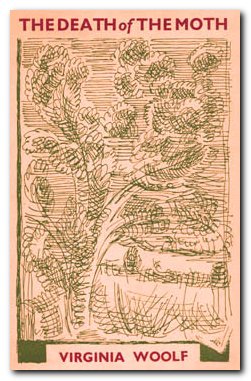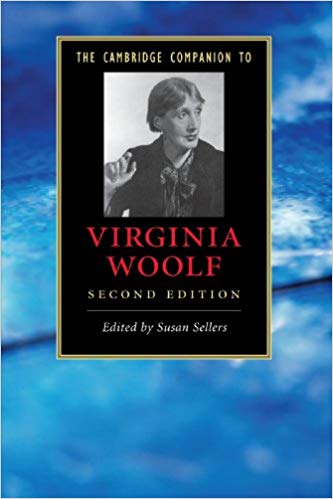essays on literature, reading, and cultural history
The Death of the Moth (1942) is the third volume of Virginia Woolf’s essays to be published after the success of her earlier collections The Common Reader first series and The Common Reader second series. Early preparations were made by Virginia Woolf herself, and then it appeared one year after her death, edited by her husband Leonard Woolf.
He explains in his introduction that the essays had previously appeared in The Times Literary Supplement, the New Statesman & Nation, the Yale Review, the New York Herald Tribune, the Atlantic Monthly, the Listener, the New Republic, and Lysistrata. He also goes on to point out that Virginia Woolf took immense care with even the shortest and least important of her essays and book reviews – often producing up to eight versions of a text before she was satisfied.
At the point of assembling this collection Leonard Woolf thought that the totality of Virginia’s finished essays and reviews had been located, edited, and published. But subsequent researches and retrievals from newspaper archives were to produce the later collections The Moment and Other Essays (1947), The Captain’s Death Bed and Other Essays (1950), and Granite and Rainbow (1958).
The Death of the Moth – critical commentary
The brief essay that gives this volume its title illustrates perfectly her gift for spinning literary gold out of straw. The subject is trivial and mundane – a moth fluttering against a window pane. But she observes it as a philosopher who uses the image to reflect on the most fundamental force of nature – the struggle between life and death.
She also draws out the complexities in apparently simple things – such as the words we use to speak and write. In an essay called ‘Craftsmanship’ – which was built from a radio broadcast for the BBC in a series called ‘Words Fail Me’ – she reflects on the volatility of language and our difficulties in pinning down meaning. The following Youtube illustrated audio clip gives an extract from the broadcast:
In some pieces, such as ‘Evening Over Sussex’ she not only explores the complexities of expressing her appreciation of the countryside but she also weaves into the verbal landscape her reflections on the nature of multiple personalities which construct the individual sensibility making such observations.
Three reviews of Henry James – two memoirs and the letters – almost take on the famous style of her author-subject – the long sentences, baroque syntax, and complex metaphors that his fans so admire and his detractors bewail. She dwells mainly on his relationship with England and his not-uncritical admiration for its traditions, through which she expresses her own reverence for James as a figure representing a bygone age.
Her literary criticism is of a kind that hardly exists any more. In an extended study of E.M. Forster’s novels she is lofty and magisterial, but she evaluates the works using bafflingly abstract metaphors:
there are moments — and his first novel [Where Angels Fear to Tread] provides several instances — when he lays his hand on the prize.
She believes that one of his greatest novels is Howards End – it ‘mark[s] his prime’, yet when she gets round to looking at it in detail exclaims ‘we may wonder in what mood of the moment we can have been prompted to call it a failure … the book as a whole lacks force’.
In ‘The Art of Biography’ she points out that fiction and biography cannot be easily combined because they have different goals – one towards factuality, the other towards invention. As a novelist and biographer herself, she resolves this contradiction by suggesting that biography is a young genre, that it should explore new methods, and that it acts as a modest handmaid to the work of truly imaginative and great artists.
Her reflections on the condition of young English poets in 1931 are cast in the form of a letter to ‘John’: (this is John Lehmann, who worked for Leonard and Virginia Woolf at the Hogarth Press). Against his despair that poetry was ‘dead’ she invokes the great English tradition – of Shakespeare, Donne, Crabbe, Hopkins – urges him and his friends to stop looking inward and write about other people, and implores him ‘for heaven’s sake, publish nothing before you are thirty’.
The volume ends with some vivacious polemics – a critique of lectures as a teaching method in the university education system (sixty years ahead of its time); an account of how she was forced to kill the Victorian notion of ‘The Angel in the House’ (the ideal woman) in order to become a professional author; and what might be the best antidotes to the clamour for aggression and war.
These essays are a wonderful reminder of how Woolf managed to successfully combine serious and profoundly new ideas about everyday life (particularly the lives of women) with both the wit and the erudition of someone who was truly steeped in the traditions of English literary culture.
© Roy Johnson 2016
The Death of the Moth – study resources
![]() The Death of the Moth – Amazon UK
The Death of the Moth – Amazon UK
![]() The Death of the Moth – Amazon US
The Death of the Moth – Amazon US
![]() Complete Works of Virginia Woolf – Kindle -Amazon UK
Complete Works of Virginia Woolf – Kindle -Amazon UK
![]() Complete Works of Virginia Woolf – Kindle – Amazon US
Complete Works of Virginia Woolf – Kindle – Amazon US
![]() The Death of the Moth – free eBook formats – Gutenberg
The Death of the Moth – free eBook formats – Gutenberg
The Death of the Moth – complete contents
- The Death of the Moth
- Evening Over Sussex: Reflections in a Motor Car
- Three Pictures
- Old Mrs. Grey
- Street Haunting: A London Adventure
- Jones and Wilkinson
- “Twelfth Night” At the Old Vic
- Madame de Sévigné
- The Humane Art
- Two Antiquaries: Walpole and Cole
- The Rev William Cole
- The Historian and “The Gibbon”
- Reflections at Sheffield Place
- The Man at the Gate
- Sara Coleridge
- “Not One of Us”
- Henry James: 1. Within the Rim
- Henry James: 2. The Old Order
- Henry James: 3. The Letters of Henry James
- George Moore
- The Novels of E. M. Forster
- Middlebrow
- The Art of Biography
- Craftsmanship
- A Letter to a Young Poet
- Why?
- Professions for Women
- Thoughts on Peace in an Air Raid
Virginia Woolf – the complete Essays
![]() 1925 — The Common Reader first series
1925 — The Common Reader first series
![]() 1932 — The Common Reader second series
1932 — The Common Reader second series
![]() 1942 — The Death of the Moth
1942 — The Death of the Moth
![]() 1947 — The Moment and Other Essays
1947 — The Moment and Other Essays
![]() 1950 — The Captain’s Death Bed and Other Essays
1950 — The Captain’s Death Bed and Other Essays
![]() 1958 — Granite and Rainbow
1958 — Granite and Rainbow
More on Virginia Woolf
Virginia Woolf – web links
Virginia Woolf – greatest works
Virginia Woolf – criticism
More on the Bloomsbury Group

